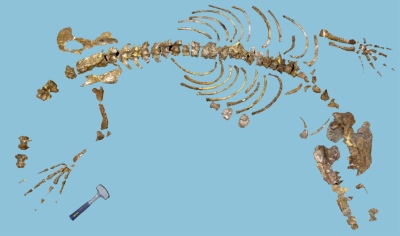Evolution of Whales: Answering Answers in Genesis
This is a response to an article on the evolution of whales at the Answers in Genesis web site: Another Whale of a Tale.
The Answers in Genesis articles are written against the evidence for the evolution of whales, one of the most well-attested lineages in nature. We can reconstruct most of the families making up whale evolution from 53 million years ago until today!
Answers in Genesis Argument One:
Pakicetids are attested only by jaw and skull fragments
AiG's "Another Whale of a Tale" article gives three arguments against the evolution of whales. The first is:
Pakicetus … it consisted only of jaw and skull fragments yet itís been claimed to be a "walking whale."
Answers in Genesis gives a 2005 date for their article, so there's really no excuse for their inaccuracy. With a little research I pulled the following image from Hans Thewissen's web site. Thewissen is one of the leading researchers on whale evolution.
 The caption at Thewissen's site reads:
The caption at Thewissen's site reads:"Photograph (above) of bones of Pakicetus (large animal) and Ichthyolestes (small animal), and a line drawing of the same skeletons."
As you can see, there's a lot more than skull and jaw fragments. Thewissen's site also gives a picture of two Pakicetus skulls that are almost complete.
Pakicetus can refer either to a family or a genus, since one of the genera in the family Pakicetidae is Pakicetus. However, the bones on the left in the picture above are from the genus Pakicetus, so there's far more than skull and jaw fragments for both the family and the genus.
Why would Answers in Genesis print something false like this about the evolution of whales?
I don't know. I've been stunned by young-earthers' dishonesty for 15 years. Somehow, even after so long a time it still astonishes me. I keep hoping for some other explanation than that they are just lying, but I'm having a lot of trouble coming up with one.
Answers in Genesis Argument Two:
Basilosaurus hind limbs are useful for grasping in reproduction.
Basilosaurus has also been offered as an ancestor to whales; while it did have hind limbs, they were far too small to have anything to do with walking. Yet evolutionists agreed that they were clearly functional, not useless, and the most common view is that they were probably used for grasping in reproduction.
This isn't an argument. There's nothing to answer.
Read my page on whale evolution. As Answers in Genesis says, evolutionists agree that these limbs might have been used for grasping while mating; however, does this answer any of the evidence I presented for the evolution of whales?
It doesn't even apply. This AiG argument is irrelevant.
Anti-evolutionists have always been confused by the multiple uses of evolving organs. As body parts evolve, so their uses can evolve as well.
Our tailbone is what remains of what was once a tail used for grasping branches in trees and for balance. Now, it is an anchor for muscles that help us balance and stand upright.
That sort of thing is common.
Answers in Genesis Argument Three:
Ambulocetus Had Nothing To Do with the History of Whales
Ambulocetus had hind limbs, and could walk; it is thus the latest fossil candidate for the evolution of whales. However, as explained in Refuting Evolution, it is doubtful that this supposed creature (constructed with some imagination) had anything to do with the history of whales.
That's a blanket statement made with no supporting evidence; however, on this page, they argue that the fibula bones, pelvis, and tail bones were not found. They also say that researchers assumed a long tail for Ambulocetus because a tail vertebrae was found five meters away from the rest of the skeleton.
Of course, no researcher would assume a long tail based on something like that. This is a ridiculous charge.
And once again—dare I say of course?—the statement is inaccurate. The following photo, again from Dr. Thewissen's web site, shows four vertebrae.
This skeleton was first described in 1994, but Answers in Genesis' 1996 and 2005 articles give inaccurate information anyway.
Also, as you can see, it is possible to estimate the length of the tail by comparing the size of the tail vertebrae and aligning them in a likely series.
 Ambulocetus skeleton first described in 1994 by Dr. Hans Thewissen
Ambulocetus skeleton first described in 1994 by Dr. Hans ThewissenIt is not just the tail vertebrae statement that is inaccurate. They tell us that the pelvis is missing, which, as you can see, is not true.
The also tell us that the fibula bones are missing. This is true, but this is a four-legged animal. The radius, the arm's equivalent of the fibula, is present and in four-footed creatures the radius and fibula are corresponding bones.
Anti- Evolutionist Arguments Against the Evidence for the Evolution of Whales
I could hunt around AiG's web site to find more inaccuracies concerning the evolution of whales, but 3 strikes and you're out. The rest of their arguments will just be more of the same.
I am not a scientist. It is a very bad thing when a non-scientist can refute supposedly scholarly arguments about the evolution of whales so easily. It took very little research to rebut their arguments.
Return to Creation vs Evolution Debate